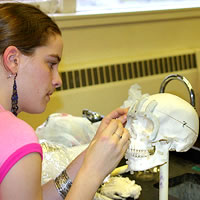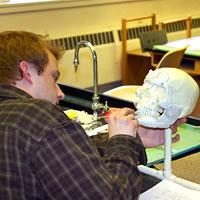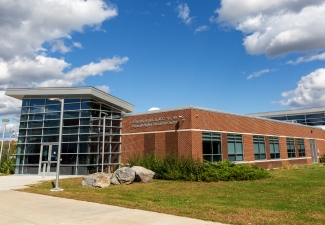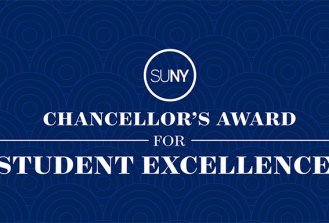Students Work Hands-on with Skulls in SUNY Plattsburgh Forensic Anthropolgy Lab
 Anna Brost studies the skull in front of her, carefully placing precisely cut strips
of clay onto the facial structure. Her goal is to reproduce the face on the skull
and to create a close likeness of what the person would have looked like while alive.Brost, along with classmates Ryan McCalla and Courtney Donovan, are working on a term
project for Dr. Mark Cohen, SUNY distinguished professor of Anthropology,
in his forensic anthropology course. Each of the three students has a replica skull.
By using clay and glue sticks, they are "re-creating" the face."I have enjoyed this project," said Brost, a junior anthropology major
from Rome, N.Y. "I found it very interesting, and I feel I learn better when I get
to do things hands-on."That's the philosophy of education that Cohen subscribes to - having students learn
by doing."I create problems instead of giving facts," said Cohen. "Having students learning
hands-on is the best way to teach. It's like throwing the students in the water making
them learn how to swim. This is a very interactive project, and I have found that
small group projects create the best environment for students to learn."Other projects have included learning how to examine cut marks and soil samples as
well as mapping and drawing techniques used in real crime scene recovery and reconstruction.
Anna Brost studies the skull in front of her, carefully placing precisely cut strips
of clay onto the facial structure. Her goal is to reproduce the face on the skull
and to create a close likeness of what the person would have looked like while alive.Brost, along with classmates Ryan McCalla and Courtney Donovan, are working on a term
project for Dr. Mark Cohen, SUNY distinguished professor of Anthropology,
in his forensic anthropology course. Each of the three students has a replica skull.
By using clay and glue sticks, they are "re-creating" the face."I have enjoyed this project," said Brost, a junior anthropology major
from Rome, N.Y. "I found it very interesting, and I feel I learn better when I get
to do things hands-on."That's the philosophy of education that Cohen subscribes to - having students learn
by doing."I create problems instead of giving facts," said Cohen. "Having students learning
hands-on is the best way to teach. It's like throwing the students in the water making
them learn how to swim. This is a very interactive project, and I have found that
small group projects create the best environment for students to learn."Other projects have included learning how to examine cut marks and soil samples as
well as mapping and drawing techniques used in real crime scene recovery and reconstruction.
The Art of Forensic Anthropology
Forensic anthropologists apply standard scientific techniques developed in physical anthropology to identify human remains and to assist in the detection of crime. Forensic anthropologists frequently work in conjunction with forensic pathologists and homicide investigators to identify a dead person, discover evidence of foul play, and/or how much time has elapsed since death. This line of work has recently become popular due to the hit television show, CSI.In addition to assisting in locating and recovering suspicious remains, forensic anthropologists work to suggest the age, sex, ancestry, stature and unique features of a decedent from the skeleton."I'm trying to figure out as much as I can from the skull," said McCalla, a sophomore anthropology major from Ballston Spa, N.Y. "Some of the things to detect include the age, sex and geographic origin. This can be difficult by looking just at the skull. If I had the pelvis too, it would be much easier."A Time-Consuming, Intense Project
 McCalla has researched his skull and, by comparing it to widely accepted charts compiled
from autopsies of known people, has determined that it is from an African-American
male, whom he has affectionately named "Bruce." This research is labor intensive and
can be very time consuming."This project has to be the most challenging project that I have ever done," said
Donovan, a sophomore anthropology major from Shirley, N.Y. "I like to pay attention
to the process of the skull I am working on."Using clay, various lengths of cut glue sticks, scalpels and various shaping tools,
the students carefully create a face for the skull. The charts tell the students where
to place the glue stick pieces on the skull and how long they should be. After the
glue stick pieces are attached to the skull, clay is then molded onto the skull like
skin, with the depth regulated by the glue stick pieces."Working on the skull is more like forensic art - part science, part art," said McCalla.
"I am making the closest reproduction that I can by following the proper methods and
using my artistic ability. We want to get a likeness that can be identified by a family
member or police officer, for example."
McCalla has researched his skull and, by comparing it to widely accepted charts compiled
from autopsies of known people, has determined that it is from an African-American
male, whom he has affectionately named "Bruce." This research is labor intensive and
can be very time consuming."This project has to be the most challenging project that I have ever done," said
Donovan, a sophomore anthropology major from Shirley, N.Y. "I like to pay attention
to the process of the skull I am working on."Using clay, various lengths of cut glue sticks, scalpels and various shaping tools,
the students carefully create a face for the skull. The charts tell the students where
to place the glue stick pieces on the skull and how long they should be. After the
glue stick pieces are attached to the skull, clay is then molded onto the skull like
skin, with the depth regulated by the glue stick pieces."Working on the skull is more like forensic art - part science, part art," said McCalla.
"I am making the closest reproduction that I can by following the proper methods and
using my artistic ability. We want to get a likeness that can be identified by a family
member or police officer, for example."
A Lesson in Debunking
Cohen also teaches the students another lesson - debunking."I'm also trying to teach the students to debunk what they have seen on such television
shows as CSI. I want them to ask themselves, 'Can you do this?' I'm teaching skepticism."
Contact Information
To learn more about the Anthropology Program at SUNY Plattsburgh, please contact:Dr. James D. Armstrong, ChairProfessor of Anthropology
Office: Redcay 127
Phone: 518-564-4004
E-mail: [email protected]Ms. Ginger Johnson
Department Secretary
Office Location: Redcay Hall 103
Phone: 518-564-3003
Toll-Free Phone: (800) 398-4801
E-mail: [email protected]
News

SUNY Adirondack Students Benefit from New Dual Agreement with SUNY Plattsburgh Queensbury
